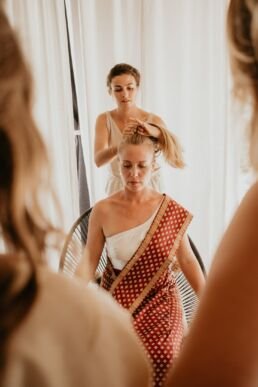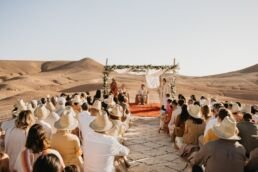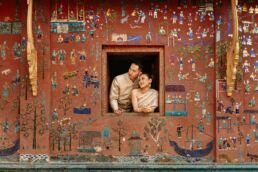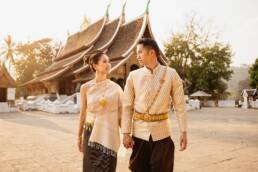About Multicultural Destination Weddings
In a world where love knows no borders, multicultural weddings are powerful celebrations of unity, identity, and connection. They represent not only two people coming together, but often two (or more!) worlds, families, and traditions finding harmony. For many couples, the celebration becomes a powerful expression of identity, heritage, and shared values, and a reminder that love transcends borders. As a photographer who works closely with multicultural couples, I’ve seen firsthand how meaningful, beautiful, and emotional these weddings can be: beautiful, vibrant, and full of heart.
Whether you’re blending rituals from different continents or simply navigating how to honor two backgrounds with care, here’s how to plan a multicultural wedding that feels deeply you: inclusive, intentional, and unforgettable.
Why Multicultural Weddings Are So Meaningful?
Multicultural weddings are more than just a fusion of styles, they’re celebrations of identity, belonging, and shared values. They reflect the journeys that brought you together and the people and traditions that shaped you.
There’s something truly moving about witnessing two worlds meet: a traditional ceremony followed by a secular one, vows exchanged in more than one language, or the couple dressed in outfits that reflect their cultural roots, or meaningful jewelry passed down through generations.
These aren’t just beautiful moments; they’re deeply personal. They carry the weight of memory, heritage, and love, and they make your celebration uniquely yours.

Tips for Blending Traditions
You can have the best of both worlds. There’s no one “right” way to plan a multicultural wedding. Some couples choose to host two full ceremonies, like a cultural celebration followed by a more western-style ceremony the next day for exemple. Others blend both cultures into one day or more.
Here are a few ideas to help you honor both (or all!) of your backgrounds:
1. Multicultural Ceremonies
There’s no one-size-fits-all approach. You can choose to have two separate ceremonies, each honoring one culture, or blend elements into one meaningful symbolic ceremony.
One common and beautiful format is to have a traditional ceremony in the morning, followed by a more western-style ceremony or reception later in the day. You might also consider hosting two ceremonies on different days over the same weekend, with all guests invited to both, or even celebrating in two different countries or hometowns, depending on what’s possible for you, your budget and your loved ones.
You can include a full traditional ceremony, or just incorporate a single ritual, prayer, or symbolic act that’s meaningful to your heritage. Both options are valid and deeply personal. The goal is to create space for your backgrounds to be seen and celebrated, whether that’s through attire, blessings, family traditions, or music.
Encouraging guests to take part – whether it’s joining in a song, participating in a ritual, or learning a few words from another language – can turn the ceremony into a shared, heartfelt experience. Finding a celebrant who is open-minded, culturally sensitive, and collaborative can make all the difference in bringing your vision to life.
2. Wedding Outfits
What you wear on your wedding day can be a powerful expression of identity and heritage, and for many multicultural couples, outfit changes are part of the joy.
Many couples choose to honor both cultures by switching looks throughout the day. For example, you might wear a sari, ao dai, qipao, or traditional Laotian sinh for the ceremony, and then change into a white dress or a tailored suit for the reception, or the other way around. You can also mix styles: a modern outfit paired with jewelry passed down from your family, or wear traditional attire with a modern twist.
These changes are not just about style, they tell a story. They allow you to pay tribute to your roots, honor your families, and celebrate who you are, together.
Tips for couples:
Coordinate with your partner so your outfits reflect both cultures in a balanced way.
- Plan extra time in the schedule for outfit changes (and touch-ups).
- Comfort matters, especially if you’ll be dancing or moving between venues.
- Include heirloom pieces like jewelry, fabric, or accessories passed down through generations, these add meaning and connection to your look.
Tips for guests:
If your wedding includes a traditional ceremony, you can invite guests to wear attire inspired by the culture, but always offer clear guidance. Let them know what’s appropriate and what’s optional.
- Share visual inspiration or examples in your invitation or on your website, especially if guests are unfamiliar with the tradition.
- For multicultural dress codes, encourage guests to wear something that feels festive and respectful, whether it’s semi-formal or incorporates a cultural touch (like a scarf, or color scheme).
Clothing is such a beautiful way to invite everyone into the celebration, and to let your personalities and heritage shine through.
3. Delicious Food
Food is a universal language of love. Offering dishes from both cultures is a delicious way to bring people together, especially if you include a small explanation or story behind each. Fusion menus for exemple can make everyone feel at home. Include family favorites or traditional drinks as a sweet nod to your roots.
4. Language
Consider bilingual ceremony readings, invitations, or vows. It’s a beautiful way to ensure both sides of the family feel included. If your families speak different languages, you can work with an officiant or celebrant who’s comfortable weaving both languages into the ceremony. Alternatively, you could print translations of your vows or key moments in a ceremony booklet, or have a bilingual friend help co-host. The important thing is that everyone feels connected and included, even if it’s not their own culture being represented.
5. Symbolism
Small gestures can go a long way: lighting a candle from each culture, mixing music from both heritages, or involving parents in rituals from both traditions. Don’t be afraid to adapt rituals to fit who you are as a couple. It’s okay to create something new from old traditions. That in itself is a beautiful form of storytelling.

Navigating Different Family Expectations with Kindness
Let’s be honest, navigating two sets of cultural or religious expectations can be one of the more delicate parts of planning a multicultural wedding. You might have parents hoping for specific rituals, or relatives unsure or even nervous about the “other side’s” traditions. It’s completely normal. And it’s also an opportunity for empathy, openness, and connection.
Multicultural weddings often involve balancing different ideas, about guest lists, religious customs, or even what a wedding “should” look like. Here are a few ways to navigate this with care:
1. Start early with honest conversations
Talk not just between yourselves, but with your families. Let them in on your vision for the wedding, and listen to theirs too. Often, hesitation comes from fear: fear of losing tradition, of not being included, or of not understanding the other culture. Reassure your families that you’re not leaving anyone behind, you’re building something new together, with love and intention.
2. Explain your choices with kindness
If you’re blending or modifying traditions, take time to explain why. One bride shared that fully embracing her partner’s cultural customs reassured his conservative family that she wasn’t “taking him away”, quite the opposite. That level of respect built trust and deepened connection on both sides.
3. Find meaningful moments of compromise
You won’t be able to please everyone, but you can make space for gestures that show care. Including a special reading, a family prayer, or a symbolic item in the ceremony, even small things, can go a long way in making families feel seen and respected.
4. Find cultural “allies” within the family
Sometimes a sibling, cousin, or trusted elder can help bridge the gap between traditions. They can explain things, advocate for you, or simply provide a calming presence when things get tricky.
5. Be clear and kind with logistics
If you’re asking family or guests to wear specific attire, participate in a ritual, or follow certain customs, let them know well in advance, and explain the meaning behind it. This helps everyone feel prepared, included, and honored.
At the end of the day, love and mutual respect are the heart of any wedding. It’s not about doing everything perfectly, it’s about making space for both of your worlds to come together, gently and intentionally.
Choosing a Destination That Feels Meaningful
For many multicultural couples, the where can matter just as much as the how. Choosing a location that feels right – whether emotionally significant or beautifully neutral – can help set the tone for the entire celebration.
Some couples opt for a neutral destination to create a sense of balance between two families and cultures. A new place, shared by all, where no one has “home court advantage.” Others choose a location filled with meaning: the country where they first met, a partner’s hometown, or a serene natural setting that represents a fresh chapter.
What matters most is that the place feels like you. That it welcomes your guests with warmth and makes space for every part of your story. That it carries the kind of energy – joyful, grounding, adventurous, peaceful – that you want to take into your married life.
Wherever you choose to celebrate, let it reflect not just where you come from, but where you’re going together.

Not every vendor understands the beauty and complexity of multicultural weddings, and that’s okay. But you deserve to work with people who are open-minded, culturally sensitive, and genuinely curious, not just about your logistics, but about your story.
Your photographer, especially, plays a unique role. Beyond capturing the big moments, they should notice and honor the small, intimate details:
– the way your mom adjusts your sari or ao dai before you walk out
– the laughter shared over a mispronounced blessing
– the quiet pause between outfit changes when you finally take a breath and soak it all in
Having vendors who understand, and genuinely celebrate, multicultural weddings makes a world of difference. You shouldn’t have to spend your wedding day explaining why something matters.
You want someone who feels the meaning behind your traditions, someone who honors the emotion in the room without needing a translation.
Here’s what to look for in the right vendors:
Experience with multicultural or interfaith celebrations
They don’t need to have done your exact combination of cultures before, but they should show care, interest, and flexibility in learning.
Open-mindedness and respect
You want someone who listens before assuming, asks questions without judgment, and embraces your vision.
Comfort with bilingual or multilingual dynamics
Whether it’s handling translations in speeches or coordinating timelines with multiple ceremonies, language sensitivity matters.
Excitement for your story, not just your Pinterest board
A great vendor will light up when you talk about your heritage, not just your color palette. They’ll see your wedding not as a “theme” but as a meaningful experience grounded in who you are.
When your vendors “get it,” they help create a wedding that feels effortless, authentic, and fully yours, not just beautiful, but deeply rooted in what matters most.
Work with Vendors Who Truly “Get It”
Not every vendor understands the beauty and complexity of multicultural weddings, and that’s okay. But you deserve to work with people who are open-minded, culturally sensitive, and genuinely curious, not just about your logistics, but about your story.
Your photographer, especially, plays a unique role. Beyond capturing the big moments, they should notice and honor the small, intimate details:
– the way your mom adjusts your sari or ao dai before you walk out
– the laughter shared over a mispronounced blessing
– the quiet pause between outfit changes when you finally take a breath and soak it all in
Having vendors who understand, and genuinely celebrate, multicultural weddings makes a world of difference. You shouldn’t have to spend your wedding day explaining why something matters.
You want someone who feels the meaning behind your traditions, someone who honors the emotion in the room without needing a translation. Here’s what to look for in the right vendors:


Experience with multicultural or interfaith celebrations
They don’t need to have done your exact combination of cultures before, but they should show care, interest, and flexibility in learning.
Open-mindedness and respect
You want someone who listens before assuming, asks questions without judgment, and embraces your vision.
Comfort with bilingual or multilingual dynamics
Whether it’s handling translations in speeches or coordinating timelines with multiple ceremonies, language sensitivity matters.
Excitement for your story, not just your Pinterest board
A great vendor will light up when you talk about your heritage, not just your color palette. They’ll see your wedding not as a “theme” but as a meaningful experience grounded in who you are.
When your vendors “get it,” they help create a wedding that feels effortless, authentic, and fully yours, not just beautiful, but deeply rooted in what matters most.
What about a multi-day celebration to have all the time you need to enjoy
If you’re feeling the pressure of fitting everything into one day – two cultures, two sets of traditions, two families’ expectations – consider spreading the celebration over several days. A multi-day wedding can actually be less stressful (and even more cost-effective) than organizing two completely separate weddings.
With a bit more time, you can slow down, breathe, and fully enjoy each moment, whether it’s a traditional ceremony, a cultural ritual, a welcome dinner, or a relaxed day-after brunch. You might choose to dedicate one day to a religious or cultural ceremony, and another to a more personal or civil celebration. This way, nothing feels rushed or squeezed in.
It also gives both sides of the family space to connect, explore, and learn about each other’s customs. It’s a beautiful opportunity to share your worlds: through food, music, clothing, traditions, and stories, in a way that feels natural and joyful.
Multi-day weddings are about creating room: for meaning, connection, and memories that last.

How I Support Multicultural Couples
Having lived and worked in different countries – including Laos and Malaysia – and being part of a multicultural relationship myself, I understand what it feels like to navigate between worlds. I’m here to:
- Help you plan photography timelines that respect different ceremonies or customs.
- Capture every outfit change, ritual, and emotional exchange with cultural awareness.
- Be a calm, grounded presence on the day, someone you can count on.
Celebrate your story, not just as your photographer, but as someone who truly sees you.
I also proudly support LGBTQ+ couples and believe that every love story deserves to be told with care, dignity, and joy, just as it is.
Your love is unique. Your story deserves to be honored, documented, and celebrated in all its richness.
Let's create memories that don’t just remind you of how your wedding looked, but how it felt.
I'll take care of you and your project
Let's craft your dream day following those guided steps
01
Reach out through my inquiry form
Don’t stress if you don’t have every detail figured out yet! Many couples who contact me are still in the early stages of planning, and that’s perfectly fine!
02
Let’s schedule a complimentary consultation
During our call, we’ll connect and chat about your vision for the day.This is where I get to know your story, what matters most to you, and how you imagine your celebration. I’ll share how I work, offer helpful insights, and answer all your questions.
03
Now we can bring your vision to life!
Once you're ready, we’ll make it official with a signed contract and retainer. From there, I’ll guide you every step of the way, from prepping for your photos to give you tips and advices, so you feel fully supported and excited for what’s ahead.
Ready to Plan Your Intimate Wedding?
Fill out the inquiry form, and we’ll schedule a consultation to discuss your wedding vision and begin planning your perfect day.
More Resources for your Wedding
Everything you want to know – I’m happy to share some free ressources to help you




